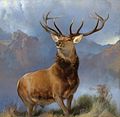Edwin Landseer
Sir Edwin Henry Landseer RA (born March 7, 1802 in London , † October 1, 1873 in London) was an English landscape , animal painter and sculptor of Romanticism and Naturalism . Landseer mainly painted animal motifs and Scottish landscapes. His most famous work as a sculptor are the lion sculptures at the foot of the Nelson statue in Trafalgar Square , London.
life and work
Landseer was born as the youngest son of the engraver John Landseer . His brothers were the history painter Charles Landseer and the engraver Thomas Landseer . Edwin Landseer was initially a student of his father, under whose guidance he began to draw animals from nature. After his apprenticeship with Benjamin Robert Haydon , he then concentrated on animal anatomical studies. In 1815 he made his debut in an exhibition at the Royal Academy , which he entered in 1816.
He first visited Scotland in his early twenties and fell in love with the Highlands . As a result, many paintings were made with Scottish motifs, one of the most famous pictures is Monarch of the Glen , now on display in the Museum of Scotland . In 1826, at the age of 24, he became an associate member of the Royal Academy of Arts . In 1831 he became a full member of the Royal Academy of Arts and court painter to Queen Victoria and her Prince Consort Albert of Saxe-Coburg and Gotha . He was beaten in 1850 by Queen Victoria to Knight Bachelor ("Sir"). In 1866 he was elected President of the Royal Academy, but did not accept the office. Since a collapse in 1840, Landseer suffered from depression and general poor health, but continued to paint until the end of his life.
Landseer primarily devoted himself to painting animals and landscapes. In 1819 he exhibited his first picture, Dog Fight . Through this and his subsequent creations, widely distributed through engraving and lithography , Landseer became popular in England and also on the continent. Among other things, he earned his living with portraits of the dogs of rich Englishmen. Landseer is also known for the Landseer dog breed , which he often painted and later even named after him , a spotted variety of the Newfoundland .
Landseer was also active as a sculptor. In 1866 he designed the large bronze figure of a deer posed by dogs and at the same time supplied the models for the colossal bronze lions at the foot of the Nelson statue in Trafalgar Square in London.
One of the bronze lions designed by Landseer in Trafalgar Square , 1866
Works (selection)
| title | Originated | Size, material | Exhibition / collection / owner |
|---|---|---|---|
| Edwin Henry Landseer (self-portrait) | 1818 | 20 × 15 cm, pencil drawing | National Portrait Gallery , London |
| Wounded Stag and Dog | 1825 | 50 × 68 cm, oil on canvas | Art Institute of Chicago in Chicago |
| High life | 1829 | 45 × 34 cm, oil on mahogany | Tate Gallery , London |
| Head of a Roebuck and Two Ptarmigan | 1830 | 22 × 30 cm, oil on panel | Art Institute of Chicago in Chicago |
| Loch Avon and the Cairngorm Mountains | circa 1833 | 35 × 44 cm, oil on panel | Tate Gallery, London |
| A dog looking out of a kennel | 1837 | 31 × 23 cm, oil on canvas | Carnegie Museum of Art , Pittsburgh |
| Dog with slipper | 1848 | oil on wood | National Museums Liverpool in Liverpool |
| Night (Two Stags Battling by Moonlight) | 1853 | 142 × 261 cm, oil on canvas | Philadelphia Museum of Art in Philadelphia |
| Doubtful crumbs | 1858/59 | 62.2 × 74.6 cm, oil on canvas | Wallace Collection , London |
| The Wild Cattle of Chillingham | 1867 | Oil on canvas | |
| Chevy | 1868 | 138 × 210 cm, oil on canvas | Detroit Institute of Arts in Detroit |
literature
- Landseer, Edwin . In: Hans Vollmer (Hrsg.): General lexicon of fine artists from antiquity to the present . Founded by Ulrich Thieme and Felix Becker . tape 22 : Krügner – Leitch . EA Seemann, Leipzig 1928, p. 107 .
- Frederic George Stephens: Sir Edwin Landseer. Sampson Low, Marsden, London 1880. ( Online in Internet Archive )
- Richard Ormond : The Monarch of the Glen. Landseer in the Highlands. National Galleries of Scotland, Edinburgh 2005.
- Richard Ormond: Sir Edwin Landseer. Exhibition catalog. Publisher: Philadelphia Museum of Art and Tate Gallery London 1981
Web links
- Works by Landseer at MuseumSyndicate
- Google Art Project - Works by Landseer for the Google Art Project.
Individual evidence
- ↑ * Landseer, Edwin . In: Hans Vollmer (Hrsg.): General lexicon of fine artists from antiquity to the present . Founded by Ulrich Thieme and Felix Becker . tape 22 : Krügner – Leitch . EA Seemann, Leipzig 1928, p. 107 .
- ↑ Edwin Landseer, RB in the database of the Royal Academy of Arts , English, accessed on May 23, 2013.
- ^ William Arthur Shaw: The Knights of England. Volume 2, Sherratt and Hughes, London 1906, p. 348.
| personal data | |
|---|---|
| SURNAME | Landseer, Edwin |
| ALTERNATIVE NAMES | Landseer, Sir Edwin Henry (full name) |
| BRIEF DESCRIPTION | English painter |
| DATE OF BIRTH | March 7, 1802 |
| PLACE OF BIRTH | London |
| DATE OF DEATH | October 1, 1873 |
| Place of death | London |








